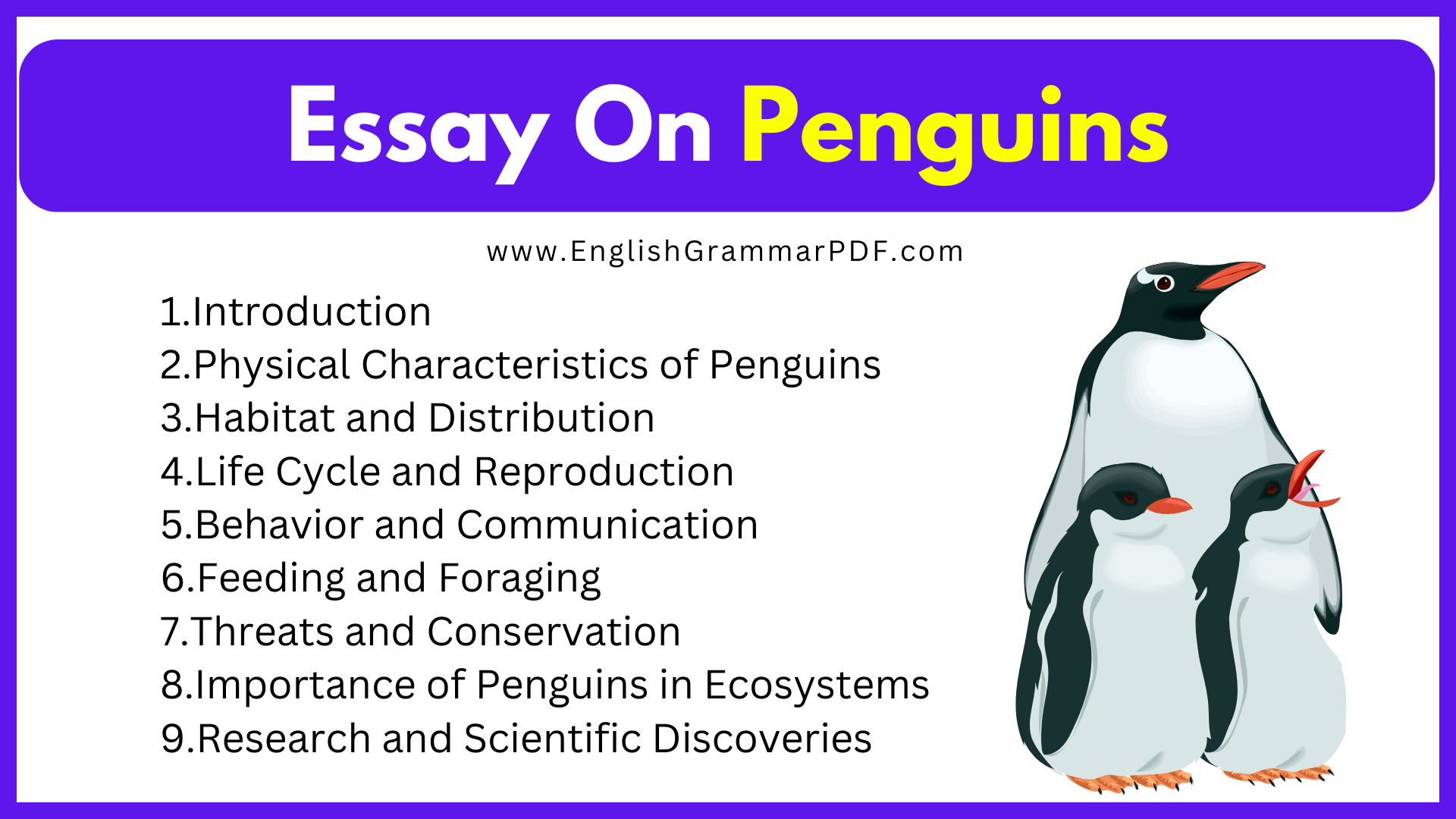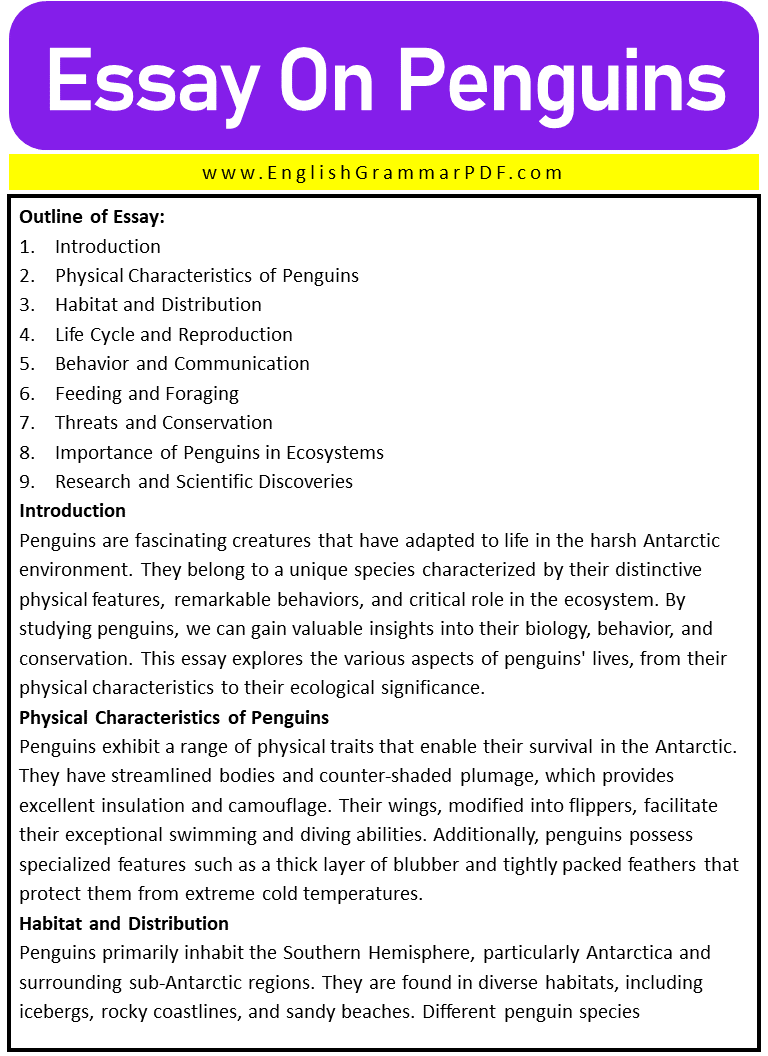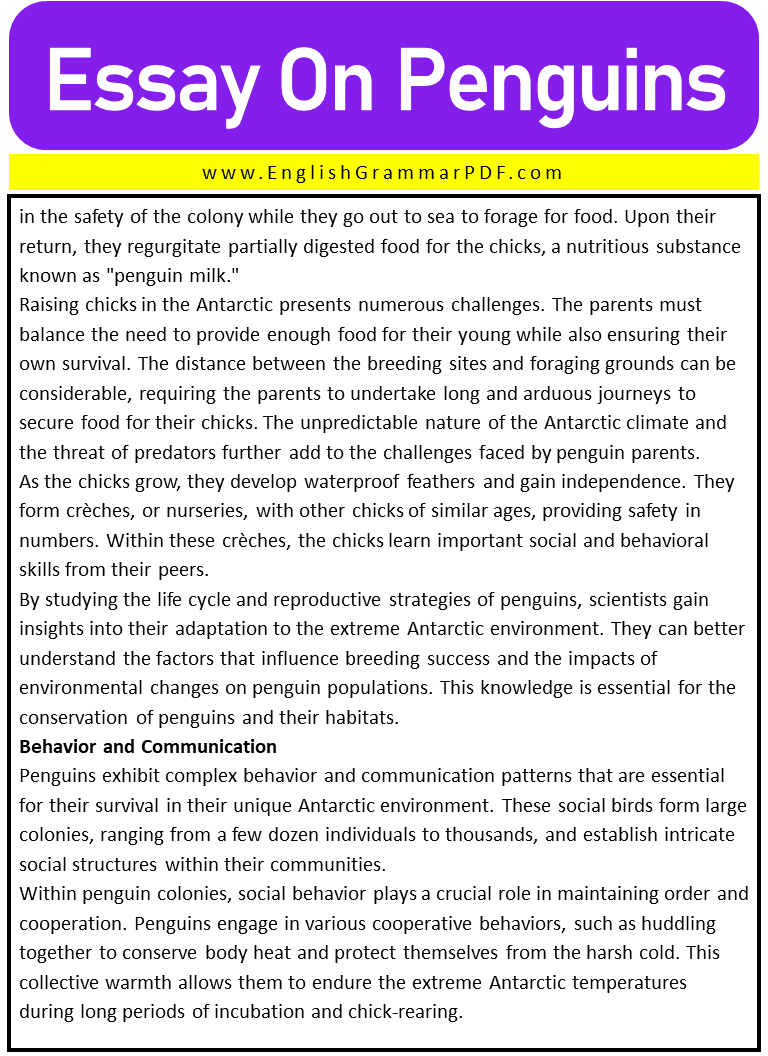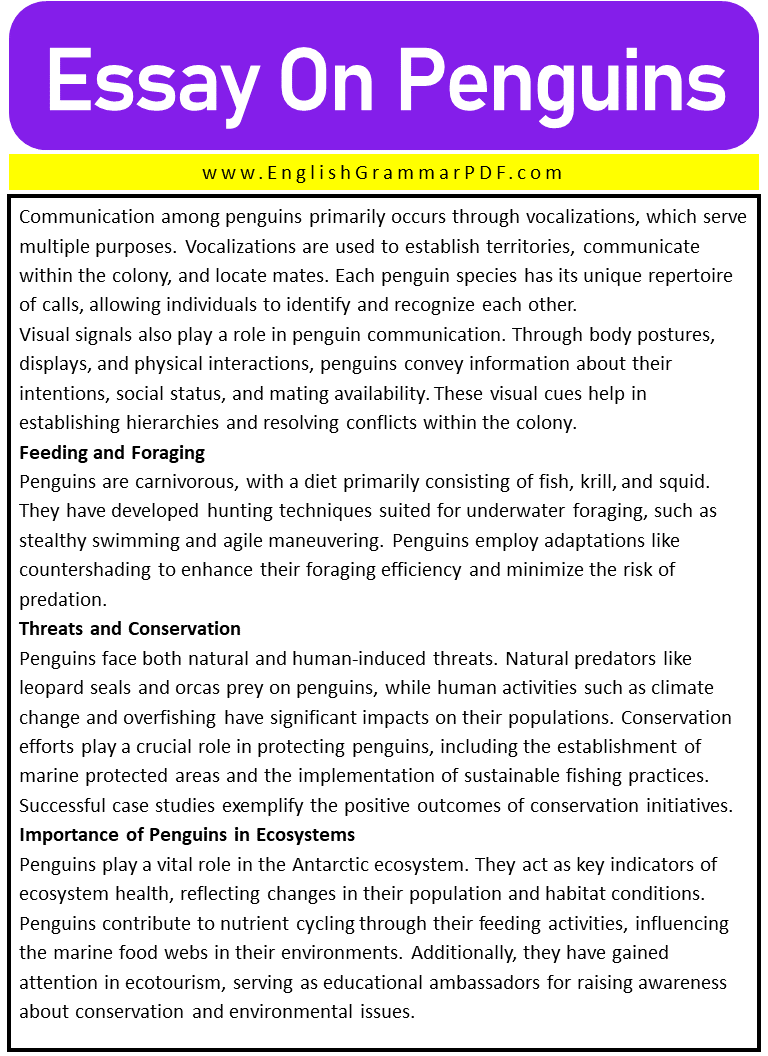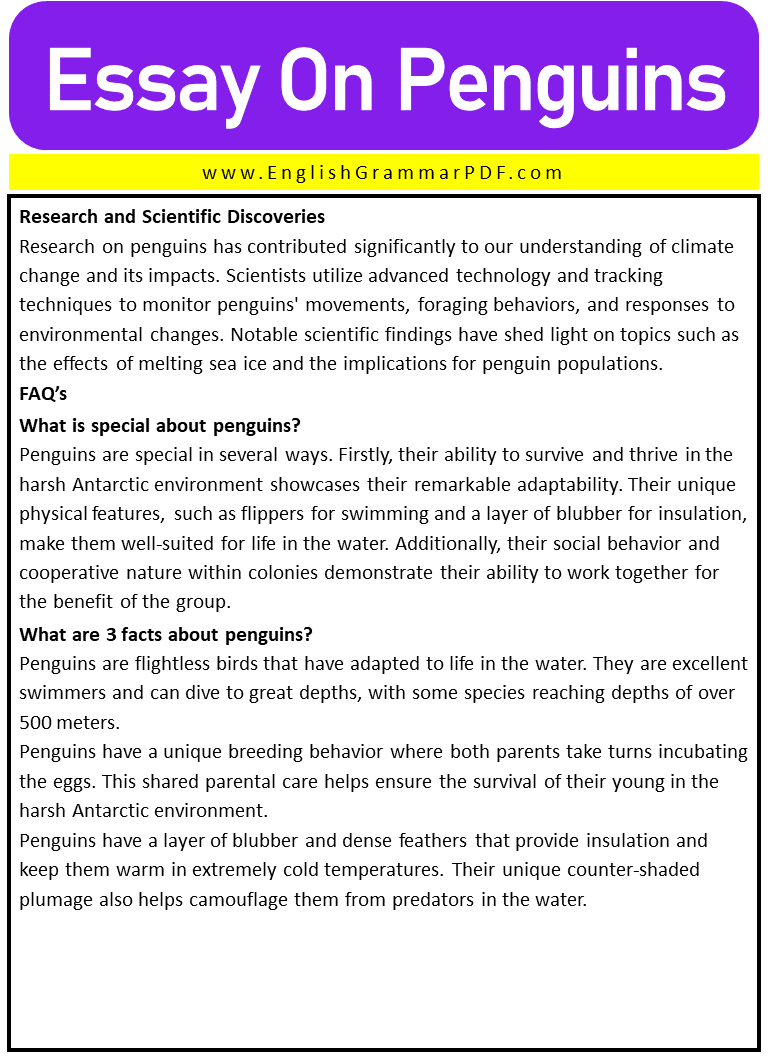Essay On Penguins
Outline of Essay:
- Introduction
- Physical Characteristics of Penguins
- Habitat and Distribution
- Life Cycle and Reproduction
- Behavior and Communication
- Feeding and Foraging
- Threats and Conservation
- Importance of Penguins in Ecosystems
- Research and Scientific Discoveries
Introduction
Penguins are fascinating creatures that have adapted to life in the harsh Antarctic environment. They belong to a unique species characterized by their distinctive physical features, remarkable behaviors, and critical role in the ecosystem. By studying penguins, we can gain valuable insights into their biology, behavior, and conservation. This essay explores the various aspects of penguins’ lives, from their physical characteristics to their ecological significance.
Physical Characteristics of Penguins
Penguins exhibit a range of physical traits that enable their survival in the Antarctic. They have streamlined bodies and counter-shaded plumage, which provides excellent insulation and camouflage. Their wings, modified into flippers, facilitate their exceptional swimming and diving abilities. Additionally, penguins possess specialized features such as a thick layer of blubber and tightly packed feathers that protect them from extreme cold temperatures.
Habitat and Distribution
Penguins primarily inhabit the Southern Hemisphere, particularly Antarctica and surrounding sub-Antarctic regions. They are found in diverse habitats, including icebergs, rocky coastlines, and sandy beaches. Different penguin species have distinct geographic distributions, influenced by factors such as temperature, ice cover, and food availability. Understanding their habitat preferences and distribution patterns is essential for effective conservation strategies.
Life Cycle and Reproduction
Penguins have a fascinating life cycle and reproductive strategy that is adapted to their harsh Antarctic environment. Understanding their reproductive behaviors and the challenges they face in raising their young provides valuable insights into their survival and conservation.
The reproductive journey of penguins begins with courtship rituals and mating behaviors. These rituals vary among different penguin species but often involve displays and vocalizations to attract mates. Penguins form monogamous pairs, and some species show remarkable fidelity, returning to the same breeding sites and reuniting with the same partner year after year.
After mating, the female penguin lays one or two eggs, depending on the species. The eggs are typically laid in nests made of pebbles, which help protect them from the freezing ground. Both parents take turns incubating the eggs, with each parent spending several weeks in the nest without feeding. This shared parental care allows one parent to go foraging while the other guards the eggs from predators and the extreme cold.
The incubation period can last anywhere from 30 to 70 days, depending on the species. During this time, the parents endure harsh weather conditions, including blizzards and sub-zero temperatures. To protect the eggs from the cold, penguins huddle together in large groups, forming a tight circle known as a huddle. This huddling behavior helps conserve heat and shields the eggs from the harsh Antarctic winds.
Once the eggs hatch, the parents face the challenge of feeding and raising their chicks. Penguin chicks are born covered in soft down feathers, which provide insulation but are not yet waterproof. The parents take turns leaving the chicks in the safety of the colony while they go out to sea to forage for food. Upon their return, they regurgitate partially digested food for the chicks, a nutritious substance known as “penguin milk.”
Raising chicks in the Antarctic presents numerous challenges. The parents must balance the need to provide enough food for their young while also ensuring their own survival. The distance between the breeding sites and foraging grounds can be considerable, requiring the parents to undertake long and arduous journeys to secure food for their chicks. The unpredictable nature of the Antarctic climate and the threat of predators further add to the challenges faced by penguin parents.
As the chicks grow, they develop waterproof feathers and gain independence. They form crèches, or nurseries, with other chicks of similar ages, providing safety in numbers. Within these crèches, the chicks learn important social and behavioral skills from their peers.
By studying the life cycle and reproductive strategies of penguins, scientists gain insights into their adaptation to the extreme Antarctic environment. They can better understand the factors that influence breeding success and the impacts of environmental changes on penguin populations. This knowledge is essential for the conservation of penguins and their habitats.
Behavior and Communication
Penguins exhibit complex behavior and communication patterns that are essential for their survival in their unique Antarctic environment. These social birds form large colonies, ranging from a few dozen individuals to thousands, and establish intricate social structures within their communities.
Within penguin colonies, social behavior plays a crucial role in maintaining order and cooperation. Penguins engage in various cooperative behaviors, such as huddling together to conserve body heat and protect themselves from the harsh cold. This collective warmth allows them to endure the extreme Antarctic temperatures during long periods of incubation and chick-rearing.
Communication among penguins primarily occurs through vocalizations, which serve multiple purposes. Vocalizations are used to establish territories, communicate within the colony, and locate mates. Each penguin species has its unique repertoire of calls, allowing individuals to identify and recognize each other.
Visual signals also play a role in penguin communication. Through body postures, displays, and physical interactions, penguins convey information about their intentions, social status, and mating availability. These visual cues help in establishing hierarchies and resolving conflicts within the colony.
Feeding and Foraging
Penguins are carnivorous, with a diet primarily consisting of fish, krill, and squid. They have developed hunting techniques suited for underwater foragings, such as stealthy swimming and agile maneuvering. Penguins employ adaptations like countershading to enhance their foraging efficiency and minimize the risk of predation.
Threats and Conservation
Penguins face both natural and human-induced threats. Natural predators like leopard seals and orcas prey on penguins, while human activities such as climate change and overfishing have significant impacts on their populations. Conservation efforts play a crucial role in protecting penguins, including the establishment of marine protected areas and the implementation of sustainable fishing practices. Successful case studies exemplify the positive outcomes of conservation initiatives.
Importance of Penguins in Ecosystems
Penguins play a vital role in the Antarctic ecosystem. They act as key indicators of ecosystem health, reflecting changes in their population and habitat conditions. Penguins contribute to nutrient cycling through their feeding activities, influencing the marine food webs in their environments. Additionally, they have gained attention in ecotourism, serving as educational ambassadors for raising awareness about conservation and environmental issues.
Research and Scientific Discoveries
Research on penguins has contributed significantly to our understanding of climate change and its impacts. Scientists utilize advanced technology and tracking techniques to monitor penguins’ movements, foraging behaviors, and responses to environmental changes. Notable scientific findings have shed light on topics such as the effects of melting sea ice and the implications for penguin populations.
FAQ’s
What is special about penguins?
Penguins are special in several ways. Firstly, their ability to survive and thrive in the harsh Antarctic environment showcases their remarkable adaptability. Their unique physical features, such as flippers for swimming and a layer of blubber for insulation, make them well-suited for life in the water. Additionally, their social behavior and cooperative nature within colonies demonstrate their ability to work together for the benefit of the group.
What are 3 facts about penguins?
Penguins are flightless birds that have adapted to life in the water. They are excellent swimmers and can dive to great depths, with some species reaching depths of over 500 meters.
Penguins have a unique breeding behavior where both parents take turns incubating the eggs. This shared parental care helps ensure the survival of their young in the harsh Antarctic environment.
Penguins have a layer of blubber and dense feathers that provide insulation and keep them warm in extremely cold temperatures. Their unique counter-shaded plumage also helps camouflage them from predators in the water.
Explore More Essays:
Download the PDF of Essay
